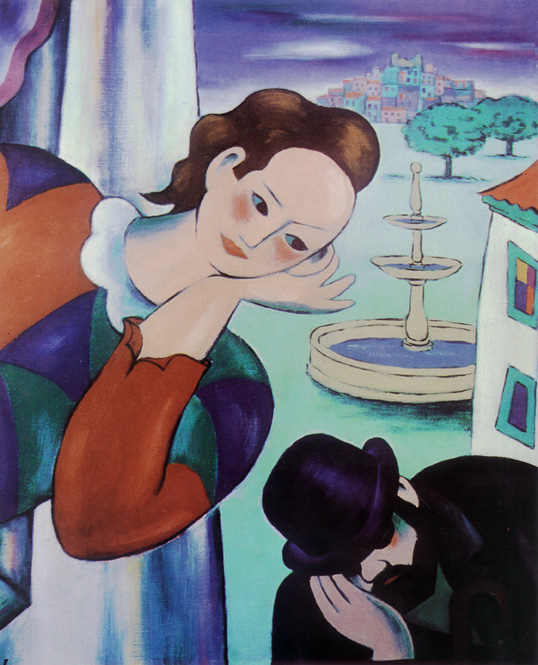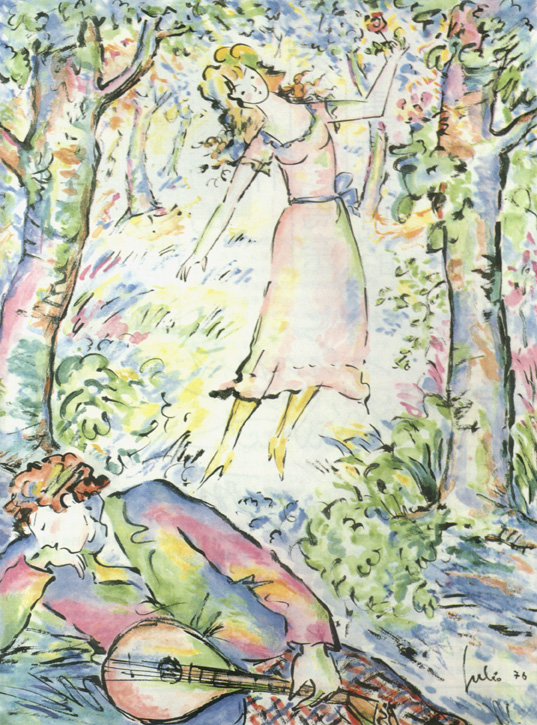Júlio and Saúl Dias, two names,
two pseudonyms for one and the same poet: Júlio, the
painter, the plastic poet; Saúl Dias, the poet of words
and of the music of sounds. They both are the
protagonists of the poetic art of Júlio Maria dos
Reis Pereira, an artist of Portuguese modernism,
born in 1902 in Vila do Conde, where he died in 1983.

Júlio and Saúl Dias, two names, two pseudonyms for one and the same poet: Júlio, the painter, the plastic poet; Saúl Dias, the poet of words and of the music of sounds. They both are the protagonists of the poetic art of Júlio Maria dos Reis Pereira, an artist of Portuguese modernism, born in 1902 in Vila do Conde, where he died in 1983.
There is in Júlio and Saúl Dias a course made of parallel and converging ways in which the "muda poesia" (mute poetry) Camões spoke of(1) -painting - completes itself and meets with poetic melody, the "pintura que fala" (painting which speaks)(2), in an essential creative unity. A singular case of convergency of poetry, painting, and music; a music which one does not hear but feels in the poems' lines, in the vibrations of trace and colour, a music which is the support of the oniric movement of Júlio's characters in the stories he tells about the world of dream and of the mind, which is his own.
There is a quantitative difference between the poetic production of Júlio and Saúl Dias, which must be emphasized: Saúl Dias published seven small books - between 1932 and 1980-which were compiled, when the author was still alive, in one volume(3); it is a restrained, depurated, years-old poetry, to complete a poem. By his turn, Júlio, the painter, develops a more apparent, intensely productive activity, having been an active participant in the modernist movement in Portugal.
Under a necessarily general perspective, we could say that the works of Júlio are born out of a lyrical expressionism (1927), develop in his first abstract (1932) and surrealistic (1935) experiments and find their continuity in an original, characteristic poetic depuration, especially perceptible in the drawings, water colours and oil-paintings of his last phase. An ever-growing artistic activity which ended only with his death and which is, admittedly, one of the greatest in the history of 20th century Portuguese painting.(5)
Holding a degree in civil engineering (University of Oporto), Júlio dos Reis Pereira carried out his professional activity only insofar as was demanded by his family needs and responsibilities-where the writer of the present article is, being the only child of the poet, included - keeping the best of his time for the production of his autonomous, independent artistic works, exempt from both official orders and influences and dominant tendencies. Being an engineer was, for him, a way of being independent, of being able to carry out coherently an innovatory work, a poetic vigour in which each step is the sequence of the previous, worth in its own terms, in the terms of what has come before, and in terms of what is expected to follow.
 Some critics have related Júlio's works to 'naif' painting. It is true that some of the charming values which characterize the works of naive painters, Sunday painters, can be found in Júlio, but it is important to emphasize that his painting is an erudite one and must be considered as such, being the result of a purifying work of knowledge and sensitivity. An artisan's work which employs those values which are original, pure, essential and superior in the human mind: love, tenderness, purity, harmony, a delicate spiritual sensuality, a subtle vision which becomes more and more deeply suggested, less and less explicit. It is interesting to notice how those references are synthesized in the titles of his last three books: Gérmen (1960) - (germen) the pure, original values -, Essência (1973) - (essence) the search for the essential, exempt from what is superfluous -, Vislumbre (1979) - (glimpse) the brief signs which are suggested to our sensitivity, to the skin of our mind, the subtle invitation of the artist into his world of surprise, dream, and enchantment. To the poet, the world of True Happiness for Man.
We must also stress, as Bernardo Pinto de Almeida also refers, that some of the most apparent aspects of the influence of the Far-East masters upon modern western painting and poetry became increasingly evident in the works of Júlio. There even is in Júlio, at times, a certain "orientalization" of the faces of his emblematic characters: the "girl" and the "poet". The poetry of Saúl Dias, likewise contained and depurated, does not fail to evoke the short Japanese and Chinese poems. Perhaps that was why his recent exhibition in Macau was so successful. (6)
BIOGRAPHIC NOTE
ON BERNARDO PINTO DE ALMEIDA
Bernardo Pinto de Almedia, a poet, a critic, and an essayist, was born in 1954 and is at present a junior lecturer on Art History at the University of Minho, Portugal. He is a member of the International Art Critics Association. Besides his books of poems, he has published a Breve Introdução à História da Pintura Portuguesa no séc. xx. (Brief Introduction to the History of Portuguese painting in the 20th century) - a Portuguese - English edition and a book on Angelo de Sousa for the 'Imprensa Nacional - Casa da Moeda'. Being a researcher on the 20th century Portuguese painting, he has written articles for newspapers and magazines and collaborated in the organization of exhibitions.
Translated by João Libano
Some critics have related Júlio's works to 'naif' painting. It is true that some of the charming values which characterize the works of naive painters, Sunday painters, can be found in Júlio, but it is important to emphasize that his painting is an erudite one and must be considered as such, being the result of a purifying work of knowledge and sensitivity. An artisan's work which employs those values which are original, pure, essential and superior in the human mind: love, tenderness, purity, harmony, a delicate spiritual sensuality, a subtle vision which becomes more and more deeply suggested, less and less explicit. It is interesting to notice how those references are synthesized in the titles of his last three books: Gérmen (1960) - (germen) the pure, original values -, Essência (1973) - (essence) the search for the essential, exempt from what is superfluous -, Vislumbre (1979) - (glimpse) the brief signs which are suggested to our sensitivity, to the skin of our mind, the subtle invitation of the artist into his world of surprise, dream, and enchantment. To the poet, the world of True Happiness for Man.
We must also stress, as Bernardo Pinto de Almeida also refers, that some of the most apparent aspects of the influence of the Far-East masters upon modern western painting and poetry became increasingly evident in the works of Júlio. There even is in Júlio, at times, a certain "orientalization" of the faces of his emblematic characters: the "girl" and the "poet". The poetry of Saúl Dias, likewise contained and depurated, does not fail to evoke the short Japanese and Chinese poems. Perhaps that was why his recent exhibition in Macau was so successful. (6)
BIOGRAPHIC NOTE
ON BERNARDO PINTO DE ALMEIDA
Bernardo Pinto de Almedia, a poet, a critic, and an essayist, was born in 1954 and is at present a junior lecturer on Art History at the University of Minho, Portugal. He is a member of the International Art Critics Association. Besides his books of poems, he has published a Breve Introdução à História da Pintura Portuguesa no séc. xx. (Brief Introduction to the History of Portuguese painting in the 20th century) - a Portuguese - English edition and a book on Angelo de Sousa for the 'Imprensa Nacional - Casa da Moeda'. Being a researcher on the 20th century Portuguese painting, he has written articles for newspapers and magazines and collaborated in the organization of exhibitions.
Translated by João Libano

"Painting"(Oil-paint 1929. a collection of Dr. Mario Soares)

Water-colour of the series "Poet"
NOTES
(1) Os Lusíadas (Vll,76)
(2) ibid (VIII, 41) Camões speaks about poetry.
(3) Obra Poética, 1980. Literary Critic's Award of the year.
(4) Júlio organized and participated in several exhibitions in Portugal and abroad since 1930.
(5)Júlio was a researcher on the paintings of the Far-East masters.
(6)The exhibition in Macau is expected to be the first in a series to be held in the Eastern countries with which Portugal holds bonds of affinity.
*Engineer, scholar and publisher of Júlio/ Saúl Dias; son of painter/poet.
start p. 69
end p.